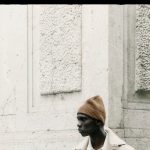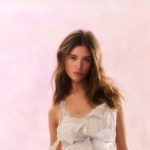The one thing you need to know about Kozaburo Akasaka’s spring show is that everyone looked absolutely cool. The designer made his New York runway debut in a warehouse space in Brooklyn, with two drummers flanking the runway as models walked this way and that around little swirly piles of rocks that were sometimes covered in surplus denim or ties, like a Zen garden for modern anxiety. A few elements tied the show together, chief among them a preponderance of denim, a high-waist with a double waistband (belted on the second row of belt loops), and a pair of weird small glasses with blinders that were very chic. Taking in the whole presentation was akin to spending 15 minutes quietly people-watching in a new neighborhood: you’re trying to figure out who’s who by the clothes they’re wearing. It was exactly what Akasaka intended.
“My starting point is the characters that live in the ‘Land of Setting Sun,’ which is the imaginary utopia I created through my branding,” Akasaka said after the show. Every model had their own essence and energy, they were characters—but not archetypes—and all wore expertly cut clothes. See a model in a red denim Canadian tuxedo with an oversized denim trucker jacket and royal blue cowboy boots; see another in a softly draped short sleeve button down shirt tucked into low-slung denim trousers with a pattern that resembled a snake’s path in the sand, cut extra-long to completely obscure the feet underneath, who was also carrying an old-school briefcase in one hand. Also see the model in a lightweight tweed wool suit cut with an extra-long jacket and pleated pants, and a semi-sheer button down with a delicately cut picot-edge placket with snaps.
On closer inspection, patterns started to emerge. Almost every look had something sssshapely about it; the clothes had curved edges, denim was embellished with a matching piping that snaked around the legs, and patterns included an “s”-shaped pattern or movement. Before getting into fashion, Akasaka studied philosophy and religious studies, and began looking at the representation of snakes across various different cultures. “Through my research I found that in Africa, China, and Japan, there’s always this representation of the snake motif, as life, power, or good luck; the snake as representative of nature.” A bold yellow and maroon graphic print jacket seemed to have its roots in the water spirit Mami Wata, while a button down shirt and matching trousers in a warm silver were embossed to achieve a crinkle texture that also suggested the slithering of a snake on the ground.



